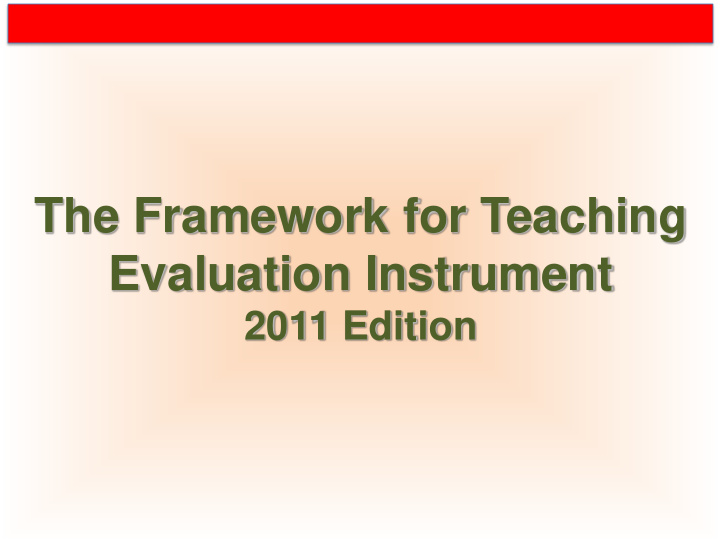



The Framework for Teaching Evaluation Instrument 2011 Edition
Wisdom of Practice If you were to walk into a classroom, what might you see or hear there (from the students as well as the teacher) that would cause you to think that you were in the presence of an expert? What would make you think: “Oh, this is good; if I had a child this age, this is the class I would hope for.”
Features of A Framework for Teaching • Generic: applies to all grade levels, content areas • Not a checklist • Not prescriptive: tells the “ what ” of teaching, not “ how ” • Comprehensive: not just what we can see • Inclusive: Novice to Master teacher
Structure of the Framework • Domains • Components • Elements • Indicators of Performance • Rubric • Levels of Performance • Possible Examples of Performance at each level • Critical Attributes at each level
Defining What T eachers Do The Domains 1. Planning and Preparation 2. The Classroom Environment 3. Instruction 4. Professional Responsibilities
Domain 1: Planning and Preparation 1a: Demonstrating Knowledge of Content and Pedagogy 1b: Demonstrating Knowledge of Students 1c: Setting Instructional Outcomes 1d: Demonstrating Knowledge of Resources 1e: Designing Coherent Instruction 1f: Designing Student Assessments
Domain 4: Professional Responsibilities 4a: Reflecting on Teaching 4b: Maintaining Accurate Records 4c: Communicating with Families 4d: Participating in a Professional Community 4e: Growing and Developing Professionally 4f: Showing Professionalism
Domain 2: The Classroom Environment 2a: Creating an Environment of Respect and Rapport 2b: Establishing a Culture for Learning 2c: Managing Classroom Procedures 2d: Managing Student Behavior 2e: Organizing the Physical Space
Domain 3: Instruction 3a: Communicating with Students 3b: Using Questioning and Discussion Techniques 3c: Engaging Students in Learning 3d: Using Assessment During Instruction 3e: Demonstrating Flexibility and Responsiveness
A Framework for T eaching: Components of Professional Practice Domain 2: The Classroom Environment Domain 1: Planning and Preparation a. Creating an Environment of Respect a. Demonstrating Knowledge of Content and Rapport and Pedagogy b. Establishing a Culture for Learning b. Demonstrating Knowledge of Students c. Managing Classroom Procedures c. Setting Instructional Outcomes d. Managing Student Behavior d. Demonstrating Knowledge of Resources e. Organizing Physical Space e. Designing Coherent Instruction f. Designing Student Assessments Domain 4: Professional Domain 3: Instruction Responsibilities a. Communicating with Students b. Using Questioning and Discussion a. Reflecting on Teaching Techniques b. Maintaining Accurate Records c. Engaging Students in Learning c. Communicating with Families d. Using Assessment in Instruction d. Participating in a Professional Community e. Demonstrating Flexibility and e. Growing and Developing Professionally Responsiveness f. Showing Professionalism
Getting to Know The Framework’s Rubric Categories, Descriptors, Elements, Critical Attributes, and Examples
Domain 1: Planning and Preparation Component Unsatisfactory / Basic / Needs Proficient Distinguished Failing (PDE) Improvement (PDE) 1e: Designing The series of learning Some of the learning Teacher coordinates Plans represent the coherent experiences are poorly activities and materials knowledge of content, of coordination of in-depth instruction aligned with the are suitable to the students, and of resources content knowledge, instructional outcomes instructional outcomes to design a series of understanding of different students’ needs, and available and do not represent a and represent a moderate learning experiences coherent structure. cognitive challenge but aligned to instructional resources (including with no differentiation for outcomes and suitable to technology), resulting in a The activities are not different students. groups of students. series of learning activities designed to engage Instructional groups designed to engage students students in active partially support the The learning activities in high-level cognitive intellectual activity and instructional outcomes, have reasonable time activity have unrealistic time with an effort by the allocations; they represent allocations. Instructional teacher at providing some significant cognitive Learning activities are groups do not support the variety. challenge, with some differentiated appropriately instructional outcomes differentiation for different for individual learners. and offer no variety. The lesson or unit has a groups of students. Instructional groups are recognizable structure; the varied appropriately with progression of activities is The lesson or unit has a some opportunity for student uneven, with most time clear structure, with choice. allocations reasonable. appropriate and varied use The lesson’s or unit’s of instructional groups. structure is clear and allows for different pathways according to diverse student needs.
Benefits of Using a Framework for Teaching • Common Language • Similarity of vision for teaching that improves teaching: the qualities of the distinguished level • Greater validity and reliability potential for teacher evaluation • Changes in novice thinking • Opportunities for collaboration
Teachscape Training Modules: Continuous Improvement and Reflect on Teaching Practices
15
16
17
18
19
20
21
22
Questions??? 23
Recommend
More recommend